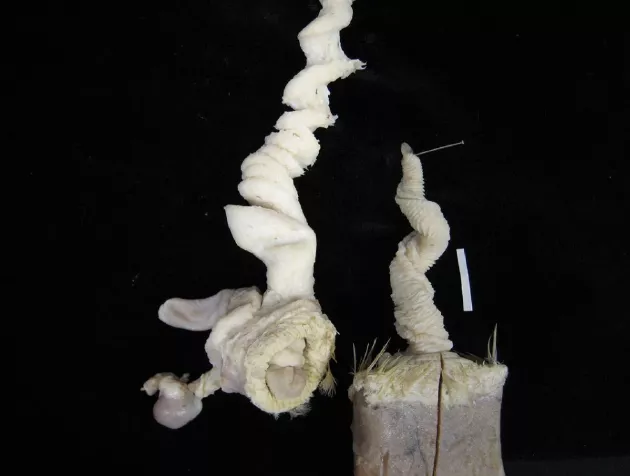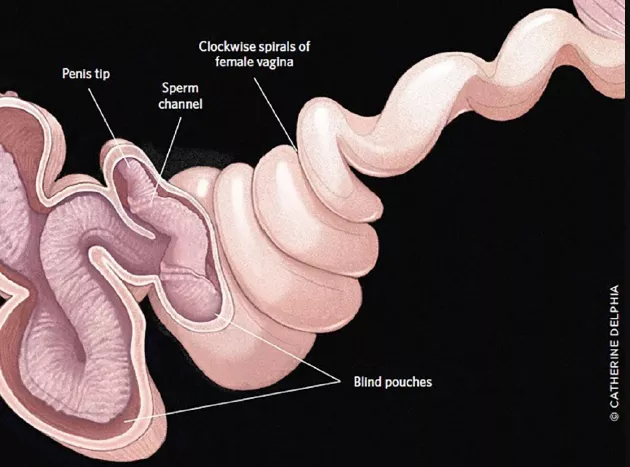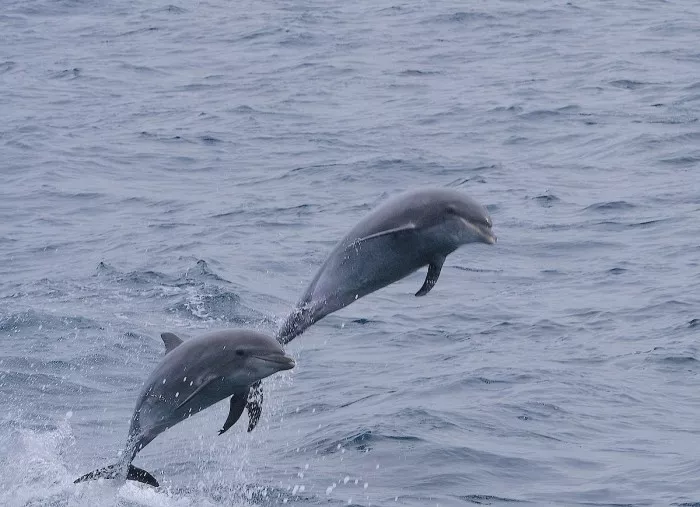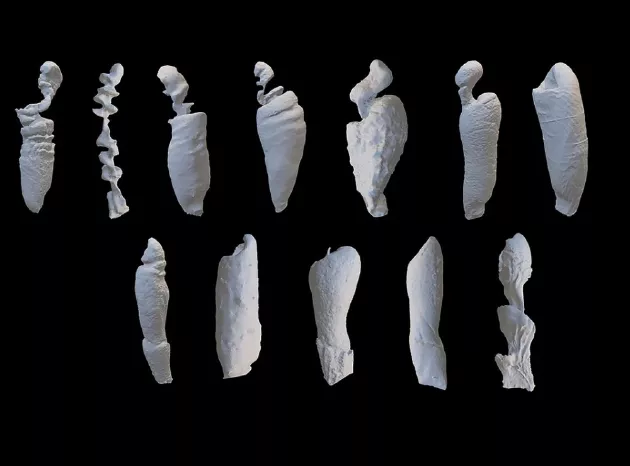From ducks to dolphins, many female animals have evolved very "wild" sexual organs to help them deter unwanted suitors and gain pleasure from non reproductive behavior Patricia Brennan never thought she would be a defender of the vagina. In fact, her research journey began with the penis of an animal.
It was an afternoon in the late summer of 2000, and the 28 year old Colombian biologist was following her research subject, a stout gray blue bird, dagi, living in the dense Costa Rican rain forest. The sun was swallowed by the canopy of the upper layer, making the ground of the forest as gloomy as ever. The weather was stifling wet and her protective clothing was soaked with sweat. "If you die in that forest, there may be no trace of you in a few months," she recalls. "You'll disappear completely."
Just then Brennan heard the bird's voice: a pure, whistle like tone with a sad bass. A male is courting. Just as she was holding her breath, a female appeared from the thick bushes. It ran to the male bird, first retreated, and then ran to catch up with it. Finally, the female squats down, cocks up her tail and asks the male to ride up. Brennan saw through the telescope that the male clumsily climbed onto the female's back. She will never forget what happened next.

In September 2021, Brennan dissected a female Verbena snake in the laboratory of the manholian College of Arts and Sciences.
For most birds, mating is a skill free thing. Because they have no external genitalia, they only have a multipurpose opening under their tail for waste discharge, spawning and mating (biologists often call this hole cloaca, which means "sewer" or "drain" in Latin, while Brennan simply calls it vagina because it performs all the same functions). Usually, two birds rub their genitals briefly, a behavior known as "cloacal kiss", in which the male transfers sperm to the female. The whole process only takes a few seconds.
But this time, the two birds began to stagger around and stick together. The male bird begins to insert; When he finally separated from the female, Brennan saw something dangling around him - a long, white, curled thing.
"What the hell is that?" Brennan remembered the thought he had flashed, "Oh, my God, it has worms." Then she immediately thought, "my God, is that a penis?"

The incised female duck vagina (left) and the corresponding male duck penis (right) are twisted in the opposite direction.
Brennan thought at the time that birds had no penis. In her two years of studying birds at Cornell University, she never heard her colleagues mention birds' penises. Cornell University is an authoritative institution in the field of bird research in the world. In any case, it was clearly not like any penis Brennan had ever seen - it was ghostly white, curled like a bottle opener, and thin like a piece of cooked spaghetti. Why did they evolve such organs that are not found in almost all birds? In Brennan's view, this is really "an extremely strange evolutionary phenomenon".
After returning to Cornell University, Brennan decided to learn all about bird penises. It turns out that not many birds have penises. 97% of birds have no penis, and only a few birds, including ostriches, EMUs and kiwi (Kiwi), have this organ. However, birds' penises are very different from those of other mammals: they are spiral and can erect and enter the female body in a very short time, which depends on lymph rather than blood; When ejaculating, the sperm will move downward along the spiral groove on the outside.
Brennan was the first person to observe that Da Kai had a plug-in penis. Later, she asked a question that distinguishes herself from her peers: if it's a penis, how does the vagina deal with it? "Obviously, if there was no place for such a thing, it would not have evolved." "You need a garage to park," she said This is the first time she wants to know the size, shape and function of a bird's vagina.

Brennan carefully dissected the female duck's spiral reproductive tract and found that its torsion direction was just opposite to that of the male duck's reproductive organs.
In 2005, Brennan's exploration of bird penises prompted her to come to the University of Sheffield in the UK before turning her research focus to bird vaginas. She realized that "we have a huge knowledge gap in the very basic part of bird biology", so she turned her research direction to the evolution of bird penis. At Sheffield University, she studied the art of dissecting bird genitalia under the guidance of bird evolutionist Tim berkhead. At first, she dissected quails and finches, which had almost no external genitalia. Then she cut open a male duck from a nearby farm and held her breath.
The penis of the male is very thin, just like spaghetti. The penis of the male duck in front of us is thick and large, but it also has an iconic spiral shape. Wait, Brennan thought to himself, where is this thing going?
No one seems to know the exact answer. One headache is that the typical bird anatomy technique is almost entirely focused on males. When researchers dissect a female duck, they cut from both sides of the vagina to the thin tubes used to store sperm near the uterus (in birds, this part is called the shell gland), distorting the real anatomical structure. Then, researchers often throw away the rest without checking. Brennan recalled that when she asked berkhead what the female duck's reproductive tract looked like, the latter thought it was just like other birds: it was just a very simple tube.
However, Brennan knew very well that a complex and unusual organ like the penis of a male duck could not evolve on its own. If the penis looks like a long spiral bottle opener, the vagina should have the same complex structure.
The first step is to find some female ducks that can be dissected. Brennan and her husband drove to a nearby farm and bought two Peking ducks. Without ceremony, she euthanized them on a bundle of hay. (Brennan's husband is used to such short trips. "He brought me an animal killed by a car as a wedding gift," Brennan said.) This time, instead of cutting the reproductive organs from both sides, Brennan spent several hours carefully peeling off the tissue layer by layer, "just like opening a gift". Finally, a complex shape emerged: twisted like a maze, with both dead ends and hidden compartments.

When Brennan showed the results of the anatomy to berkhead, they both looked carefully again. Berkhead had never seen anything like this before. He called a colleague in France, a world-class expert in duck reproductive anatomy, and asked him if he had heard of these structures. The colleague gave a negative answer. He also examined one of his female duck specimens and reported the same finding: an "extraordinary vagina".
According to Brennan, females seem to respond to males in some way, and vice versa. However, she found something strange: the direction of vaginal distortion is opposite to that of the penis. In other words, the vagina seems to have evolved not to adapt to the penis, but to avoid the penis. "It's hard for me to understand. I can't do it," Brennan said. She kept the structures of these genitals in formalin specimen bottles and spent several days observing them repeatedly, trying to find out why they were complex.
From this time, Brennan began to think about the conflict between the sexes. She knew that the mating process of ducks was notoriously violent. The mating period of ducks usually lasts at least one season. However, some males who do not find a mate will lurk in the flock, ready to harass and ride on any female who already has a mate. This usually leads to fierce fighting, and the male duck can hurt or even drown the female duck. In some species, up to 40% of mating is forced. The researchers believe that this tension stems from different competitive goals between the sexes: males want to reproduce as many offspring as possible, while females want to choose the father of their children.
Brennan speculates that this conflict between the sexes may also shape the genitalia of ducks. She began contacting scientists in North and South America to collect more specimens. Kevin McCracken, a geneticist at the University of Alaska in the United States, was one of them. During a winter trip, he found the longest known bird penis on the South American hard tailed duck. After being untied, the maximum length reached a staggering 43 cm. McCracken believes that perhaps this is the male's response to the female's preference, but he did not bother to carefully observe the female's genitals.
Brennan called McCracken, who was very happy to help her collect more specimens. Now, McCracken admits that the reason he didn't consider examining females may be his own male bias. "It's perfect for a woman to follow up," he said. "We don't need a man to do it."

In 2018, Auerbach and Brennan made vaginal models of 14 marine mammals and found that cetaceans showed unprecedented vaginal diversity. Many times, Auerbach can simply identify species by vaginal morphology. Here are vaginal models of cetaceans, finnopods and manatees.
After carefully dissecting the genitalia of 16 species of waterfowl, Brennan and colleagues found that the vaginal diversity of ducks was unparalleled compared with any known bird. Many stories have happened in the vagina of female ducks. The main reason for the evolution of such a vagina seems to be to make it more difficult for male ducks to enter: it is like a medieval chastity belt to prevent men from inserting. In some cases, the female duck's reproductive tract prevents the penis from fully expanding, and the vagina is filled with pouch structures, and the sperm entering these structures will die naturally. In other cases, the muscles around the cloaca can prevent unwanted males from entering, but they can also expand to allow favorite suitors to enter.
Whichever way the female chooses, they succeed. In ducks, only 2% to 5% of the offspring are the result of forced mating. As the males become more aggressive and physically stronger, the female's reproductive tract becomes longer and more complex. "When you dissect these birds, it's easy to predict what the other sex looks like," Brennan said This is a struggle for reproductive control, not just physical autonomy: although females cannot avoid physical harm, their body structure can help them control the genes of their offspring after forced mating.
Brennan realized that the duck's vagina was not the passive, simple structure biologists used to think. In fact, this is a carefully controlled machine that can say "no" to the penis. So what about other animal groups?
A new world unfolds before Brennan's eyes: a wide variety of animal vaginas, amazing diversity, but they have not been explored yet. For centuries, biologists have admired penises, carefully observing their length, circumference and force. Brennan's observation of reproductive organs seems to be very simple. She found that animals' vaginas were far more complex and changeable than people thought. Usually, they play an active role in deciding whether to allow males to enter, how to deal with sperm and whether to help males inseminate. The vagina itself is an amazing organ, "full of glands, muscles and collagen, constantly changing and fighting pathogens," Brennan said. "It's an amazing structure."
Brennan knows that to put females at the center of genital research, we need to observe more animals - not just ducks - and more widely open the "mating black box" of female genitalia. Moreover, in exploring the genitalia - from the tiny Y-shaped snake penis to the spiral bat vagina - she continues to find the same story: males and females seem to have evolved together in a sexual arms race, leading to the development of exquisite sexual organs on both sides.
However, it turns out that conflict is not the only force shaping the genitalia.
For decades, biologists have found a strange feature in the reproductive tract of marine mammals such as dolphins, whales and porpoises: a series of fleshy folds, like stacked funnels, extending to the cervix. In the literature, they are called "vaginal folds" and are thought to have evolved to prevent sperm killing seawater from entering the uterus. However, according to Dara aubach, a doctoral student studying dolphin sex organs in Canada, this function does not explain the morphological changes she found. In 2015, she got to know Brennan by chance. She also brought her frozen whale vaginal specimens to Brennan's Laboratory for further research.
The initial discovery immediately reminded them of the genitals of ducks. For example, the vagina of harbour porpoises is also spiral like a bottle opener, and several folds block the path to the cervix. In turn, the end of the porpoise's penis is a fleshy protrusion, like a finger, which seems to have evolved to reach the cervix through folds. Like ducks, both male and female porpoises seem to have specific evolutionary characteristics to gain evolutionary advantage in mating.
Then, while dissecting the porpoise's vagina, the two scientists came across something unexpected: a huge clitoris, partially wrapped in wrinkled skin. For a long time, the human clitoris has been (wrongly) shaped into a small and difficult shape, but the clitoris of porpoises is almost impossible to ignore. When it is completely dissected, it is even bigger than a tennis ball. "It's really huge," Brennan said.
It is not surprising that porpoises have a well-developed clitoris. Brennan and Auerbach both know that these attractive marine animals often have sex for reasons such as happiness and social relationships. Female porpoises have been seen masturbating by rubbing their clitoris against sand, other dolphins' noses and objects on the sea floor. But while other scientists have speculated that the porpoise's clitoris may have a function, no one has really tried to figure out what it does.
The clitoris of 11 porpoises were dissected and scanned by a micro CT scanner. They found a roughly triangular tissue complex at the opening of the vagina - easily accessible to the penis, snout or fin limb. These tissues are composed of two types of erectile tissues, which are spongy and rich in pores, making them prone to congestion and erection. During adolescence, these erectile tissues grow and change shape, indicating that they play an important role in the sexual life of mature individuals. Surprisingly large nerves, up to half a millimeter in diameter, form a sensitive network of nerve endings under the skin of the clitoris.
In short, the clitoris of porpoises looks very similar to that of humans, the two scientists wrote in a paper published in January. They are likely to have the same function. Brennan is not sure if porpoises have orgasms, "but I'm pretty sure they feel good during sex. Or at least rubbing their clitoris."
Before porpoises, even Brennan did not think much about the possible role of non reproductive behavior in genital evolution. In general, she agrees with the principle of classical Darwinian evolution: "in my opinion, everything must be conducive to reproduction in the end." She believes that these behaviors may encourage future reproductive behavior and eventually bring more offspring. Alternatively, the male's ability to stimulate the clitoris may also affect the female's choice of partner.
In fact, Darwin left much to be improved in the evolution of reproductive organs. The father of evolution often avoided talking about genitalia, believing that their main function is to combine mechanically, like a lock with a key. In addition, he almost universally describes female animals as pure, modest and almost free of sexual impulse. In some less well-known works, Darwin describes a world in which females respect their "husband" very much and abide by the "marriage oath". Although he also observed some counterexamples, such as some female animals have several "husbands", and some females seem to only pursue sexual pleasure. Perhaps out of Victorian etiquette consciousness, Darwin avoided all this.
In Darwin's view, males are the group with sexual driving force. In contrast, the role of females is mainly to choose between competing males. "Males are almost always courters; only they have special weapons to fight their opponents," he wrote in his 1871 book "descent of man, and selection in relation to sex." they are usually stronger and taller than females, and have the necessary qualities of courage and aggressiveness. "
A century and a half later, Darwin's influence still cast a far-reaching shadow in this field. In his direct exploration of the vagina of female animals, Brennan began to question some bad evidence in Darwin's heritage, such as prudence, male bias and lack of curiosity about female genitalia. However, she inherited some of these frameworks, that is, she still linked genitalia mainly to reproductive sexual behavior, that is, sexual behavior between the opposite sex.
However, the discovery of porpoises made Brennan stop and think. In front of her, the huge rat dolphin clitoris suggests something that seems obvious, but often less obvious: sex is not just for reproduction.
Today, we know that genitalia is much more than just a mechanical combination. They can also signal, attract attention or flirt - not only to potential partners, but also to other members of the group. In evolution's Rainbow: diversity, gender, and sexuality in nature and people, published in 2004, evolutionary biologist Joan lavgaden pointed out that in humans, dolphins and other species, sexual behavior can be used to strengthen friendship and alliance, make dominant and submissive gestures, and as part of social negotiations such as reconciliation and mediation.
These other uses of sex may be one of the reasons why animal genitalia is more strange and wonderful than the standard vaginal / penile combination. Think of the female spider monkey's long, drooping clitoris, which can be used to send out smell; More widely known is the clitoris of female hyenas, which is almost as large as the penis of male hyenas and is used for urination, mating and fertility; Darwin briefly emphasized that the striking genitalia of some monkeys - such as the rainbow colored genitalia of black tailed monkeys, ghost baboons (black faced mandrills) and mandrills, and the red and swollen hips of female macaques during estrus - may represent social status and help groups avoid conflict.
These are examples of the diversity of "reproductive geometry" (a term proposed by Ralph gaden), indicating that genitalia has many other uses besides reproduction. "All our organs are multifunctional," lavgaden pointed out. "Why can't genitals be like this?"
Homosexual behavior is common throughout the animal kingdom. For example, in female dominated species such as bonobos, same-sex mating is at least as common as heterosexual mating. It is worth noting that female bonobos have huge, cantaloupe sized labia swelling and prominent clitoris, which can be up to 6 cm when erecting. Some primatologists even believe that the location of such a striking clitoris - facing forward like humans, rather than inside the vagina like pigs and sheep - may have evolved to promote same-sex genital friction.
Primatologist Amy Parrish said: "logically, it's really better for their sexual behavior types." Parrish, who is mainly engaged in the study of bonobos, is the first person to describe bonobo society as a matriarchal society. Primatologist Frans de Waal also believes that "the positive orientation of the bonobo's vulva and clitoris strongly indicates the adaptation of the female genitalia to this posture." Therefore, lougaden creatively called this clitoris form "the mark of Sappho" (Sappho is an ancient Greek lyric poet who once expressed his love for women in a female tone and is regarded as a symbol of lesbian). Like chimpanzees, bonobos are the closest primates to us in evolution - they share 98.5% of our genes. With this in mind, lavgaden wondered why no more scientists had asked the question: Would the same force work in humans?
These questions cannot be raised by the current sexual selection framework, which is based on the simple assumption that males are aggressive and females are selective. Darwin took it for granted that the basic unit of nature is male female pairing, which always leads to reproduction. Therefore, his theory that shy females choose competing males can only explain a limited part of sexual behavior. Those who followed in his footsteps also saw heterosexuality as "the only real sex" and all other sexual orientations as exceptions, or just out of curiosity.
The impact of this classification goes beyond biology. The exclusion of homosexual behavior of animals and the treatment of these animals as deformities or exceptions make the negative attitude towards human sexual minorities more specific. Today, Darwin's theory is often misused to preach what human nature should be or should not be. As a transgender woman, loughgaden became transgender a few years ago when she wrote the rainbow of evolution, and she saw the harm more clearly than most people. She wrote in the book that sexual selection theory "denies my place in nature and crams me into a stereotype. I tried, but I can't stand it."
Focusing only on dramatic examples of sexual conflict, such as studies on the "gender war", masks other powerful forces shaping genitalia. Doing so may leave out species that cooperate and negotiate closely between the sexes, including monogamous seabirds such as albatrosses and penguins, and species with as strong same-sex relationships as heterosexual relationships. In fact, the highly diverse animal genitals seem to be shaped by the same diverse driving forces, including conflict, communication and the pursuit of pleasure.
In Brennan and lougaden's view, this is an embodiment of freedom. "Biology does not need to limit our potential. Nature provides a variety of lifestyles," lavgaden wrote
This article is excerpted from vagina obscura: an anatomical voyage by Rachel E. Gross。 (Ren Tian)